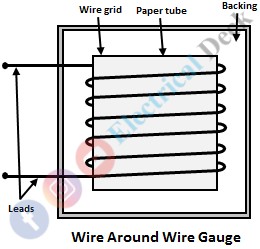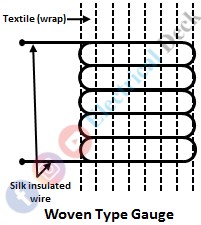The strain gauge is a transducer used to measure strain and associated stress in experimental stress analysis. When a metal wire (or conducting wire) is stretched or compressed, its length and diameter change due to which the resistance and also the resistivity of the wire will change.
This effect is known as the Piezo-resistive Effect. All the strain gauges operate on the principle of piezoresistive effect. Hence, these are also referred to as piezo-resistive gauges.
Types of Strain Gauges :
Electrical resistance strain gauges are mainly classified into two types. They are,- Unbonded strain gauges, and
- Bonded strain gauges.
Unbonded Strain Gauge :
In an unbounded strain gauge, the strain gauge is not directly bonded to the surface which is subjected to stress or which is under study. It consists of resistance wire stretched between frames A and B with the help of insulated pins as shown below. These two frames are movable with respect to each other, and this arrangement can be connected in one of the arms of Wheatstone's bridge.
When the pressure or force which is to be measured is applied, frame A moves with respect to frame B. This causes a change in the length and cross-section of the strain gauge which in turn causes its resistance to change.
Due to this change in resistance, the bridge will be unbalanced and produces some output voltage, which indicates the change in resistance, which in turn gives the value of applied pressure.
Specifications of Unbonded Strain Gauge :
- Typical size - 0.003mm in diameter and 25mm in length
- Resistance - 120Ω, 350Ω to 1000Ω
- Maximum excitation voltage - 5 V to 10 V
- Construction material - Nichrome, constantan, nickel.
Advantages of Unbonded Strain Gauge :
- It has greater accuracy.
- This gauge can be used in the range of ±0.15% strain.
Disadvantages of Unbonded Strain Gauge :
- It requires more space.
Applications of Unbonded Strain Gauge :
- Can be applied in the measurement of pressure, acceleration, and force.
- Used in those systems where gauge can be placed at different places and requires measurement of pressures or stress frequently or more number of times.
Bonded Strain Gauge :
Bonded strain gauges are directly placed or bonded on the surface of the device or component which is subjected to stress or which is under study. The bonded strain gauges are again divided into three types,
- Wire Type strain gauge,
- Foil Type strain gauge,
- Semiconductor strain gauge.
i. Wire Type Strain Gauge :
These are available in bonded and unbonded types. In bonded type, the strain gauge is directly pasted on the surface of the structure under test. To paste the strain gauge on the structure, adhesives are used which are responsible for transmitting the strain from the structure to the gauge wires. These gauges are basically fabricated in four varieties namely,
- Flat grid wire gauge,
- Wrap around wire gauge,
- Single wire gauge,
- Woven type gauge.
Flat Grid Wire Gauge : In flat grid wire gauges, the fine wire is arranged in the form of a grid (i.e., wound back and forth) and then pasted on a backing material (ex: epoxy, paper, etc), with the help of adhesive as shown below. Transverse strains cause changes in resistance at the ends of each section where the wires are looped around.
By maintaining the length of loops at a minimum or joining them with some material that is less sensitive to strain compared to the actual material used in the fabrication of the gauge, the cross-sensitivity can be reduced. In order to get maximum transfer of strain from the structure under test to gauge, the grid structure should be placed as close as possible to the structure under test. This also helps to maintain the hysteresis and creep at a minimum.
Wrap Around Wire Gauge : In wrap-around wire gauges, the fine wire is wound on a thin strip or a flattened tube of paper. These can be made smaller in length for the same value of resistance compared to flat grid type. However, in this type the wire grid is in two planes, the gauge has a very high surface thickness. Due to these creep and hysteresis increases.
Single Wire Gauge : This type of wire gauge is mainly designed to avoid the cross-sensitivity factor. These are formed when single wires are stretched across and laid as shown below.
In order to avoid looping of the same material, thick copper wires are attached (welded) at the ends. Due to this, cross-sensitivity reduces to a great extent.
Woven Type Gauge : This gauge is formed when a silk-insulated eureka wire is wound as the weft on a textile or rayon wrap. These gauges can measure large strains and are also used to carry out tests on leather and fabrics.
ii. Foil Type Strain Gauge :
Foil gauges differ from wire gauges from a constructional point of view. In foil gauges, the required grid pattern is formed with a very thin foil which is the same material used for wire gauges. Due to the larger surface area to area of cross-section ratio, it has a higher heat dissipation capability and hence better thermal stability. The strain reproducibility is excellent.
In these gauges, there is no stress concentration at the terminals due to the absence of joins. As a result, the life of the gauge gets increased. Foil gauges with complex patterns of any small size can be fabricated by virtue of the versatile photochemical etching process.
Working of Bonded Strain Gauge :
The figure below shows the measurement of pressure or strain using a metal foil bonded strain gauge. A metal foil strain gauge of 0.02 mm is bonded on the surface of the device under observation.
When a force or pressure is applied to the device, its physical dimensions will change. Since a metal foil strain gauge is pasted on its surface, the dimensions of the metal foil strain gauge change, which causes it to change its resistance.
This change in resistance can be measured by connecting this gauge in one of the 4 arms of the balanced Wheatstone bridge. This connection makes the bridge unbalance, and some output voltage will be generated which gives the value of resistance. This measured resistance gives the applied force.







